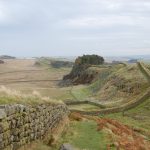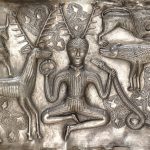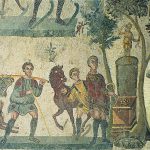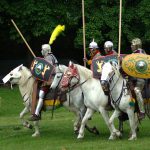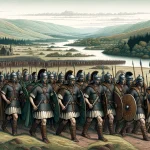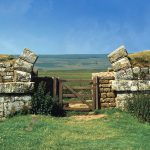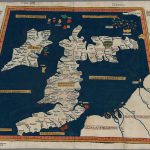Gloucester (Colonia Glevum) Roman Settlement
Colonia and Legionary Fort
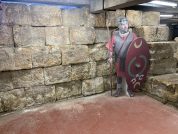
Although the beginnings of this town was that of a fort Vicus, it received Colonia Status under Nerva, and became a freestanding city.
The first Roman military presence in the area of Gloucester, which stands on the flood-plain on the eastern bank of the Sabrina Fluvius (River Severn), was a vexillation-sized fort at Kingsholm, about four hundred metres to the north-north-east of the later legionary fortress. Excavations on this site in 1972 and 1974 established an occupation date of c.49AD, which coincides with the establishment of the colonia at Camulodunum (Colchester). For this reason therefore, the site at Kingsholm has been identified as the Claudian fortress of Legio XX Valeria, which had been moved from its old base at Camulodunum (Colchester) leaving behind a colony of veteran soldiers; the legion was, therefore, under-strength at the time the Kingsholm site was built which accounts for the smaller, vexillation-sized fortress to house it.
Sometime during the period 64AD to 66AD a large legionary fortress of 43 acres (17.4 hectares) was built to the south of the Kingsholm vexillation fort, possibly by Legio XX Valeria who may have been stationed at the old site, or by detachments of Legio II Augusta brought up the Fosse Way from Isca Dumnoniorum (Exeter).
In 67AD the sudden withdrawal by Nero of Legio XIV Gemina from Viroconium (Wroxeter) to the Rhine frontier in Germany, caused a re-shuffle of the remaining Legions in Britain; the Twentieth were moved from Glevum to Viroconium, and the Second Augusta moved up to Glevum from Isca Dumnoniorum. The other British legion at this time, Legio IX Hispana, were retained on station in their fortress at Lindum (Lincoln).
The new fortress faced south-west which was presumably in order that its garrison be deployed quickly either to the south towards the Dumnonian peninsula, or to the south-west to reinforce the operations against the Silures in South Wales.
During the governorship of Sextus Julius Frontinus (73/4AD to 77/8AD) Legio II Augusta were moved from Glevum to a new fortress at Isca (Caerleon) in Gwent. It is uncertain whether any military force was on station at the Glevum fortress for the next ten years or so.
The fortress at Glevum appeared to undergo a refurbishment in c.87-88AD, with a regularly-coursed oolite wall c.4½ feet (1.4 metres) wide fronting the original rampart with the intervening space being packed with rubble, but as the Second Augusta were at that time presumably still at Caerleon, the identity of the legion that undertook the work remains open to question. It has been suggested that the legion responsible was Legio XX Valeria Victrix, recently withdrawn from their incomplete legionary fortress at Inchtuthil in the Caledonian highlands, but in the face of other evidence which suggests that they moved to either Deva (Chester) or Viroconium, their presence at Glevum at this time is doubtful.
Epigraphic Evidence of Roman Gloucester
The original R.I.B. listed only six texts on stone for Gloucester, to which have been added another three since the work was first published. There are four tombstones, two altarstones, two building inscriptions and another stone which reads DVB… LVC… (RIB 124). Many of the inscriptions mention military units, and all of the texts appear somewhere on this page.
The Roman Garrison
Aside from the Legio Vicesimae Valeria Victrix – The Twentieth Legion, Valiant and Victorious, the only other military unit attested at Gloucester is Cohors Sextae Thracum – The Sixth Cohort of Thracians, which is positively identified on a tombstone (see below). Men from this unit may be responsible for an altarstone dedicated to the Genius of the Cohort (see RIB 119 below), also perhaps a damaged building inscription which reads simply COH … I… (see RIB 3070 below).
RIB 3074 - Tombstone for Lucius Valerius Aurelius
To the shades of the dead. Lucius Valerius Aurelius, veteran of the Twentieth Legion Valeria Victrix. Julia (or Julius) […]
The crowding of (a), (b) and (c) into the spandrels and round the niche-moulding raises the possibility that they are secondary, and that IVL […] in (d) is the name of the man originally commemorated, before the stone was re-used for Valerius Aurelius. Against this is the absence of the D(is) M(anibus) formula in (d), or any details of the deceased and his executor. On balance, therefore, it seems that IVL […] is the nomen of the widow or (male) heir, even if the generous spacing leaves little or no room for a concluding formula or note of relationship, for example h(eres) f(aciundum) c(uravit). The imperial nomen Aurelius is not common as a cognomen, and although it is found as late as the reign of Diocletian for the centurion Julius Aurelius at Lambaesis (CIL viii 2660 = ILS 5787), it was evidently assumed much earlier by some soldiers in compliment to the reigning emperor, Antoninus Pius or perhaps Marcus Aurelius. This follows from the dedication to Jupiter and the genius of the new emperor Antoninus Pius in 139 (CIL vi 31147 = ILS 2182 = Speidel 1994, 45, No. 11) made by Thracians discharged from the equites singulares Augusti at Rome after 25 years’ service. They include P. Ael(ius) Aurelius and M. Ulp(ius) Aurelius, who can hardly have borne this cognomen when they enlisted in 114. This practice is important for the dating. The abbreviation of the formula Dis Manibus, and the omission of father’s name, voting-tribe and origo, mean that RIB 3074 is second-century at least, a conclusion confirmed by the costume (second-century or later, according to CSIR) and even the coiffure (Trajanic, according to Mattern). The lettering itself looks no later than the second century. The use of the cognomen Aurelius, with the ‘provincial’ nomen Valerius typical of legionaries, thus suggests that the deceased was either the son of an Antonine-period soldier or, more likely perhaps, that he assumed these names when he became a legionary in this period. See also RIB 3016 with note on Aurelius as a nomen.
RIB 121 - Funerary inscription for Rufus Sita
Rufus Sita, trooper of the Sixth Cohort of Thracians, aged 40, of 22 years’ service, lies buried here. His heirs had this erected according to the terms of his will.
TRACVM ANN XL STIP XXII
HEREDES EXS TEST F CVRAVE
H S E
Sita: Cassius Dio li, 23 mentions Sitas as a king in Thrace in 29 b.c.For a subsequent mention of this cohort see RIB 2411.152-8.
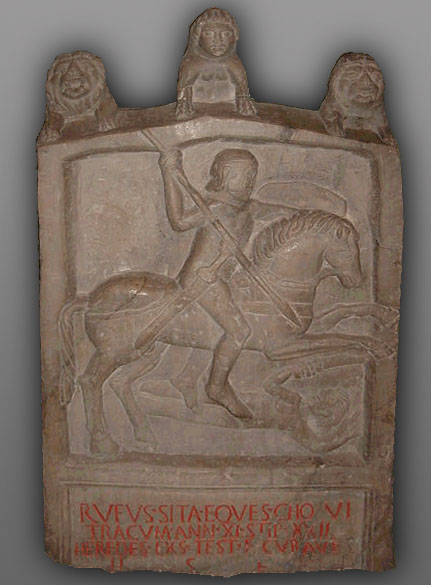
RIB 3070 - Fragmentary centurial stone
Of the [numeral] Cohort, the century of I[…] (built this).
I[...]
.[...]
In view of the find-spot, this stone belongs to the refacing of the defences soon after 87–8 (see note to RIB 3069). But unlike RIB 3069, it does not name the legion concerned (most likely the Twentieth), no doubt because, like many ‘centurial’ stones on Hadrian’s Wall, it was marking a sub-division of a cohort’s allotment. All that remains of line 3 is a loop, not easily identifiable as part of a letter. It may be part of a decorative leaf-stop (hedera): compare RIB 1659.
The Gods of Glevum
RIB 119 - Altar dedicated to the Genius cohortis
To the god, the Genius of the whole(?) Cohort, Morivendus …
GENIO CHO CVNC
[...]ORIVENDVS
[...]ṾΛV
No commentary.
There are only two altars dedicated to the gods attested at Gloucester, one to the Genio Cohortis possibly dedicated by an officer of an auxiliary unit (vide RIB 119 supra), and another which reads simply D MAR “To the god Mars“ (RIB 120; altar stone).
Colonia Nervia Glevensium
Glevum became a colony for the settlement of veterans at the end of the 1st century. The date of foundation of the colonia at Glevum can be fairly accurately assigned due to an inscription on the tombstone of a soldier found in Rome (see below). The inscription describes him as Nervia Glevi or “from Nerva’s Glevum”, which indicates that the colonia at Glevum was founded in the reign of the emperor Nerva, who reigned for a short period of sixteen months between 96AD and 98AD.

A modern statue of the emperor Nerva on horseback stands just outside the entrance to the Eastgate Shopping Centre, in the same place where pieces of a bronze equestrian statue have been recovered.
Tombstone found at Rome
CIL VI3346 - Tombstone found at Rome
To the shades of the departed Marcus Ulpius Quintus of Nervia Glevi, soldier and frumentarius¹ of Legio VI Victrix, Calidius Quietus, his colleague, had this made for his respected, most dutiful and deserving brother.
- The frumentarius was the soldier responsible for his unit’s grain supply.
Not all of the military buildings within the fortress were demolished when the military finally left Glevum, several of the barrack-blocks seem to have been left standing. In the centurions quarters at the end of one of the retained barrack buildings, there are signs that it was used as an iron-working smithy, and a pottery kiln was found in another barrack-block, both of which are certainly not military in origin.
Like the early colonia at Lindum (Lincoln), Glevum originally had a timber forum and basilica with a gravel courtyard, built on the site of the legionary principia which had been demolished, unlike Lindum however, the Trajanic forum at Glevum was built transversely across the site, so that it was no longer possible to use the main road (the legionary via praetoria and via decumana) which originally ran through the centre of the fortress.
Throughout the second century, the colonia at Glevum thrived. By the end of this period most of the old legionary buildings had been superceeded, in some cases decidedly inferior replacements had been installed, but for the most part, the buildings became both more substantial and more luxurious. Mosaic floors and tesallated pavements also started to appear towards the end of the second century.
In the late second or early third century the original legionary defences of the colonia were enhanced by the addition of internal rectangular interval towers; one in each of the four inner curvatures, five along the east and west sides, and four on the north and south. The rampart was also extended to the rear, entirely covering the remaining traces of the legionary intervallum road within the defences.
In the late third or early fourth century the curtain wall of the colonia was strengthened, some stretches were merely straightened-out and supported while other sections were underpinned with timber piles and re-built. In the same period the four gateways of the colonia had external masonry towers built.
Tombstones From Gloucester (Colonia Glevum) Roman Settlement
RIB 122 - Fragmentary funerary inscription
… soldier of] the Twentieth [Legion], from the century of Livius Saturninus, of 13 years’ service, aged 40.
No line-divisions are indicated. Addenda from RIB+add. (1995): For a centurial stone of the legion at Gloucester see now RIB 3069 (Brit. xvii (1986), 429 No. 3).
RIB 123 - Fragmentary funerary inscription
… lived 20 years Ingenuina, his wife, (set this up).
VIXI[...]
[...]NOS XX
IN[...]ENVINA
[...]ONIVNX
It may have come from the Roman villa at Stancombe Park, or it may be one of the items in that collection which Purnell brought from Cirencester (Newmarch Cirencester 23, 105, etc.).Watkin records that a stonemason, when employed to clean lichen off the stone, recut some letters. It seems likely that the more deeply cut letters vi, onos, incen, on were thus recut, and that the remaining, more shallow, letters form the untouched text.
The Local Industries of Gloucester (Colonia Glevum) Roman Settlement
A legionary tile and brick works has been found on the site of St. Oswald’s Priory, immediately north of the west gate of the fortress. This would have been situated on the south-east bank of the Sabrina, which during the Roman period approached the fortress from due north, and flowed in a wide curve around its western side approaching closest at the south-western angle; the modern River Severn now flows over one thousand yards (300 metres) away to the south-west of the Priory site. The brickworks apparently continued production following the departure of the legions, run as a commercial concern to supply the colonia and the attached town, its goods being stamped “RPG” or Rei Publica Glevensium (‘from the public works at Gloucester’).
Three first-century pottery kilns have been found outside the east gate of the colonia. The potteries of the early town thrived during the late-first and early-second centuries, producing goods in a style copied from the continent and modified to produce their own distinctive “Glevum-Ware”. By c.200AD pottery production had all but ceased, and what industries remained seem to have been mainly agricultural; certainly no evidence of extensive iron-working has been found after the late second century, which is surprising considering the proximity of the iron-rich hills of the Forest of Dean.
Military tombstones have been found at Wooton Pitch between the two fortress sites which could have belonged to either establishment, and other, civil cemeteries were located outside the south and east gates of the colonia.
Extra-mural habitation was concentrated outside the north and north-east walls, and in the land outside the west gate between the walls and the River Severn where the docks and associated warehouses were located. The largest suburban concentration was outside the north gate, and this probably marks the site of the canabae of the original legionary fortress. As the town and colonia developed through the third century, the population gravitated from the canabae site to the area between the west gate and the Sabrina, possibly indicating that the roads were by this time in a bad state of repair, and the commercial traffic was gradually being transferred to the river.
The forum in the center of the colonia was unused after the fourth century, and after this time the population of Glevum went on the decrease, as the inhabitants moved into the surrounding countryside. This is due in no little part by the general rise in overall sea-levels which occurred in the fourth century, and lying as it does on the flood-plain of the Sabrina, Glevum was plagued by problems of flooding, evidence for which has been found at several places both within and without the defences.
Possible Classical Temple
Fragments of monumental building columns have been found close to the edge of the colony around the St. Aldgate’s area. Since most public buildings were placed close to the centre of the settlement, it is very likely that these column remains represent those fronting a classical temple.
The Fate of Roman Gloucester
Little is known of fifth-century Glevum other than the re-alignment of the westgate road through a new portal in the wall some tens of metres to the north to avoid the now-ruined and blocked Roman west gate. The fate of Roman Glevum is hinted at in the Saxon Chronicle;
A.D. 577. This year Cuthwin and Ceawlin¹ fought with the Britons, and slew three kings, Commail, and Condida, and Farinmail,² on the spot that is called Derham,³ and took from them three cities, Gloucester, Cirencester, and Bath.” (Saxon Chronicle)
- Saxon warlords.
- These are name (Welsh/Gaelic)s, which suggest that by the time of the Saxon invasions, the Roman city had already fallen under the dominion of settlers from Ireland.
- 35 miles to the south of Gloucester.
Roman Remains in Gloucester and the Surrounding Area
A 4th C. Roman mosaic was found beneath the Debenhams department store in Northgate Street and is now on display in the Gloucester City Museum.

Trial trenching was performed at several sites at Gloucester/Glevum in 1969: 41-53, Eastgate Street (SO833184), 11-15 & 22, Southgate Street (SO832185), 10, Eastgate Street (SO832185), Post Office Telephone Exchange (SO830186) & 63-71, Northgate Street (SO834187). Other sites were investigated during excavations on the M5 Motorway Project in Gloucestershire, also in 1969: outbuilding of villa N of Brookthorpe (SO833125), settlement NW of Stoke Orchard (SO913289) & a T-shaped corndrier NNE of Upton St. Leonards (SO866157).
The road to Ariconium (Weston-under-Penyard) leaves Glevum slightly south of due west, then abruptly changes direction near Huntley and heads north-west. It is possible that this road also had a branch which continued directly west through the iron-rich hills of the Forest of Dean around Monmouth, to the legionary fortress at Burrium (Usk).
There are several villas in the hills to the south-east towards Corinium (Cirencester), at Ifold (SO8510), Hucclecote (SO8717), Coopers Hill (SO8914) and Dryhill (SO9316). There are other substantial Roman buildings in the Gloucester suburbs (SO8318) and in the surrounding countryside at Brookthorpe (SO8312), Willington (SO8324) and Stockend (SO8409).
References for Colonia Nervia Glevensivmcolonia Glevensisglevvm
- The Towns of Roman Britain by John Wacher (2nd Ed., BCA, London, 1995) pp.150-167 & fig.66;
- Britannia i (1970) pp.293-5; Temples in Roman Britain by M.J.T. Lewis (Cambridge 1966);
- The Roman Inscriptions of Britain by R.G. Collingwood and R.P. Wright (Oxford 1965);
- The Saxon Chronicle – AD 1 to AD 1154 translated by Reverend J. Ingram (1823).
Map References for Colonia Nervia Glevensivmcolonia Glevensisglevvm
NGRef: SO8318 OSMap: LR162
Roman Roads near Colonia Nervia Glevensivmcolonia Glevensisglevvm
WNW (13) to Ariconivm Iter XIII: ESE (10) to Colesbovrne SE (17) to Corinivm (Cirencester, Gloucestershire) SE (14) to Daglingworth NW (12) to Dymock (Gloucestershire) Ryknild Street: N (26) to Worcester SW (30) to Venta Silvrvm (Caerwent, Gwent) SSW (23) to Rangeworthy (Avon) N (22) to Kempsey SW (17.5) to Lydney Park
Sites near Gloucester (Colonia Glevum) Roman Settlement
- Kingsholm Vexillation Fortress (1 km)
Vexillation Fort - Great Witcombe Roman Villa (8 km)
Villa - Custom Scrubs (12 km)
Temple Or Shrine and Villa - Woodchester Roman Villa (15 km)
Villa - Littledean Roman Temple (17 km)
Roman Temple Or Shrine - Combend Villa (17 km)
Villa - Dymock (Macatonium) Roman Settlement (18 km)
Minor Settlement - Wycombe Temple (19 km)
Temple Or Shrine - Uley Shrine (19 km)
Temple Or Shrine - Wycomb (20 km)
Minor Settlement
